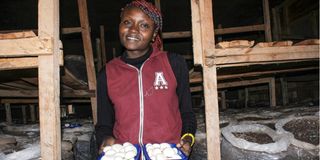Premium
Enriching leap from classrooms to mushrooms

Ruth Korat, a Kabarak University student, on her mushroom farm in Soy, Uasin Gishu County.
What you need to know:
- Currently, she grows the button variety. She started with both oyster and button but realised that the former is common but not preferred in the market.
- She sells her produce in hotels and restaurants in Eldoret town though she also gets orders from Nairobi and Mombasa.
- Demand is usually high between September and January when the number of tourists is high. On the other hand, prices drop between June and August.
- The farmer, who says she has broken even, plans to grow cremini and shiitake varieties. She also hopes to increase her produce and open a grocery or store in Eldoret dedicated to the fungi.
Ruth Korat easily finds her way inside the dark mud house in Simbi village, Soy, some 30km from Eldoret town in Uasin Gishu County.
It is harvesting time and the 24-year-old is armed with several punnets, in which she places the produce, which is ready for sale.
“I started the venture in July last year after visiting a mushroom farmer in Eldoret for some lessons. I developed an interest in mushrooms because I loved their soup, which costs high in restaurants,” says the final year clinical medicine student at Kabarak University.
She farms on part of their five-acre family land, where they also keep pigs and grow various vegetables
To start, she constructed the mud house, which has a width of 25ft, 55ft length and 14ft height, built the shelves inside to host mushroom bags, bought seeds (spawns) and prepared growing media. She used Sh200,000 capital from her mother.
The growing media
“Mushrooms are not grown on soil like other crops. The growing media is called substrate which I make from wheat grain, wheat straw, cottonseed and gypsum,” she explains, adding the crop does better in darker conditions in the first 14 days, where temperatures must be maintained above 240C and humidity above 90 percent.
After mixing the ingredients, she pours water on it for a week or leaves it out in the rain for four days.
“The process of making the substrate takes about two weeks before it is transferred in bags inside the mushroom house. For good results, we also add molasses and muriate of potash since mushrooms require potassium to help in stimulating growth.”
Currently, she grows the button variety. She started with both oyster and button but realised that the former is common but not preferred in the market.
“We get the spawns from importers who bring them from Italy and South Africa and then sell from Sh24,000 to Sh30,000 per carton, which has 30 litre of spawn.”
Ruth ends up with up to 4,000 punnets per crop cycle after about two months and harvests the mushrooms for up to a month.
Very sensitive
“I sell the punnets at between Sh130 and Sh150. Sometimes the prices can go for as high as Sh200 or fall to as low as Sh60 or Sh80 per punnet.”
She sells her produce in hotels and restaurants in Eldoret town though she also gets orders from Nairobi and Mombasa.
Demand is usually high between September and January when the number of tourists is high. On the other hand, prices drop between June and August.
“One of the challenges we have is to ensure that the crop reaches the market while still fresh because it is very sensitive. Most of the mushroom farmers from Rwanda who transport their produce to Nairobi use refrigerated system which we lack. Besides that, sometimes one can end up buying poor spawns and low quality substrate resulting in poor harvest.”
When she started last year, Ruth deferred her studies to do farming but with online classes due to Covid-19 pandemic, she is able to balance farm work and academics.
The farmer, who says she has broken even, plans to grow cremini and shiitake varieties. She also hopes to increase her produce and open a grocery or store in Eldoret dedicated to the fungi.
Small amounts of toxins
“I would advise anyone who wants to grow mushrooms to do market research and learn various practices from other farmers to avoid losses.”
Prof Violet Mugalavai, a food scientist at University of Eldoret, says that there over 2,000 edible mushrooms that include white button, oyster, cremini, shiitake, portabella, enoki andand cloud ear, but the largest is portabella, which can grow up to six inches in diameter.
“White mushrooms have more potassium, while shiitake have more fibre. But in general, all varieties have good amounts of vitamins and minerals,” says Prof Mugalavai, adding dried mushrooms have more calories and other nutrients than raw varieties because they are more concentrated.
She says many people use mushrooms such as white button in salads.
“But you're better off cooking mushrooms because it helps to release the vitamins and minerals. Certain varieties of raw mushrooms contain small amounts of toxins, including a compound that is considered carcinogenic, which is destroyed through cooking. However, cooking will not render highly toxic mushrooms safe to eat.”
****
Nutrients
When mushrooms are rehydrated before cooking or eating, their nutrition is comparable to raw versions.
Canned mushrooms are often a little higher in calories, and significantly higher in sodium than raw mushrooms due to the additives.





